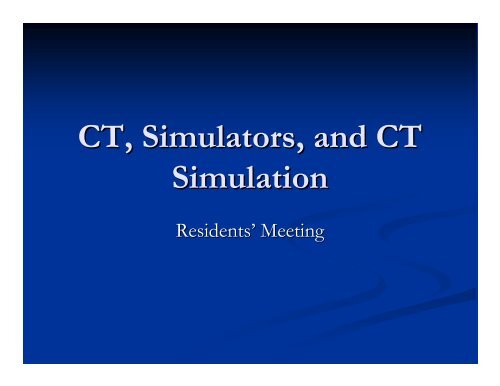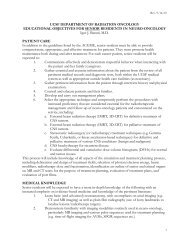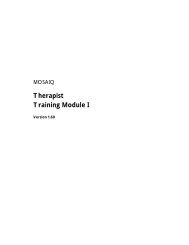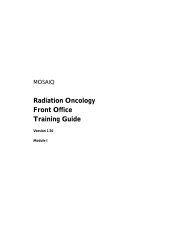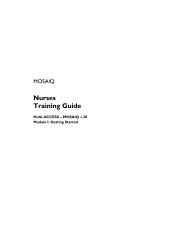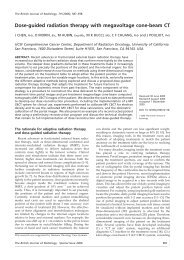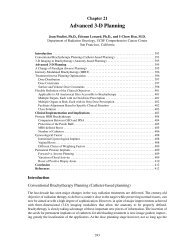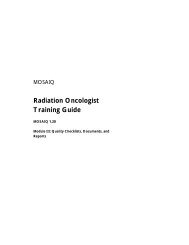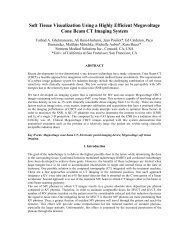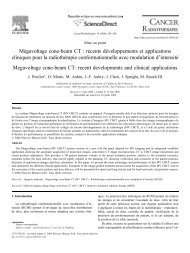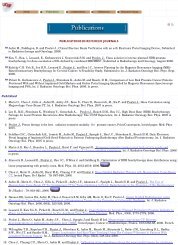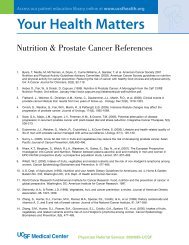CT, Simulators, and CT Simulation - UCSF Radiation Oncology
CT, Simulators, and CT Simulation - UCSF Radiation Oncology
CT, Simulators, and CT Simulation - UCSF Radiation Oncology
Create successful ePaper yourself
Turn your PDF publications into a flip-book with our unique Google optimized e-Paper software.
<strong>CT</strong>, <strong>Simulators</strong>, <strong>and</strong> <strong>CT</strong><br />
<strong>Simulation</strong><br />
Residents’ Residents Meeting
AAPM TG-66 TG 66 Report<br />
Materials<br />
http://www.aapm.org/pubs/reports/rpt_39.pdf<br />
AAPM TG-2 TG 2 Report #39<br />
http://www.aapm.org/pubs/reports/rpt_83.pdf<br />
AAPM TG-53 TG 53 Report<br />
http://www.aapm.org/pubs/reports/rpt_62.pdf<br />
NCRP Report 99
Components<br />
<strong>Simulators</strong><br />
X-ray ray tube<br />
Detector / film cassette holder: capable of fluoroscopic<br />
imaging<br />
Gantry: allows replication of linac geometry<br />
Collimator<br />
Uses<br />
Set isocenter <strong>and</strong> creation of patient positioning devices<br />
Create films for verification of patient position<br />
Set field boundaries
<strong>CT</strong> Scanners<br />
generation: tube <strong>and</strong> arc of<br />
detectors that rotate<br />
4 th generation: tube <strong>and</strong> full<br />
ring of detectors (only tube<br />
rotates)<br />
Helical acquisition: rotate <strong>and</strong><br />
translate simultaneously<br />
Multi-slice: Multi slice: increase axial<br />
length of detector array to<br />
image more than one slice at a<br />
time<br />
3 rd generation: tube <strong>and</strong> arc of<br />
LW Goldman, J Nucl Med Tech, 35(3):115- 35(3):115<br />
128, 2007
Virtual / <strong>CT</strong> <strong>Simulation</strong><br />
Use <strong>CT</strong> images to create DRR’s DRR to replicate<br />
films from simulators.<br />
Differences from a conventional <strong>CT</strong> scanner:<br />
Differences from a conventional <strong>CT</strong> scanner:<br />
External lasers for patient marking<br />
Flat table (to reproduce treatment position)<br />
Virtual simulation software<br />
Flat table (to reproduce treatment position)<br />
Virtual simulation software<br />
Other differences<br />
May require more robust x-ray x ray tube<br />
Large bore may be needed
Multi-slice Multi slice <strong>CT</strong><br />
Use x-ray x ray tube output more<br />
efficiently<br />
Acquire data faster than single<br />
slice scanners <strong>and</strong> allows<br />
thinner slices<br />
Number of slices not equal to the<br />
actual number of detectors<br />
Consider axial length of detectors as well<br />
M Prokop, Prokop,<br />
General Principles<br />
of MD<strong>CT</strong>, Eur. Eur.<br />
J. Radiology,<br />
2003, 45(S1): S4-S10. S4 S10.<br />
AAPM Summer School 2006<br />
Slices<br />
300<br />
250<br />
200<br />
150<br />
100<br />
50<br />
0<br />
1970 1980 1990 2000 2010 2020<br />
Year
Tests for <strong>CT</strong><br />
Mechanical alignment<br />
X-ray ray output<br />
Safety<br />
Image quality<br />
Virtual simulation software (may be part of<br />
treatment planning system)
Frequency<br />
Tests for <strong>CT</strong><br />
Acceptance / Commissioning<br />
Daily<br />
Monthly<br />
Annually<br />
Other
Couch<br />
Mechanical Alignment<br />
Level <strong>and</strong> orthogonal to imaging plane<br />
Position indicators should be accurate<br />
Table movement should be accurate<br />
Minimal couch sag<br />
Should not produce imaging artifacts
Lasers<br />
Mechanical Alignment<br />
Properly aligned with center slice <strong>and</strong> center<br />
Sagittal lasers orthogonal to image plane<br />
Gantry tilt: should be within 1° 1 of the nominal<br />
imaging plane<br />
Scout image should be accurate<br />
Collimation: slice thickness should be correct
X-ray ray output<br />
kV <strong>and</strong> half value layer<br />
mA-s mA linearity <strong>and</strong> reproducibility<br />
Scan time accuracy
X-ray ray dose<br />
Safety<br />
Measured in terms of <strong>CT</strong> dose index (<strong>CT</strong>DI)<br />
<br />
T is the slice thickness, n is the number of slices/scan<br />
<strong>CT</strong>DI 100 is the same as <strong>CT</strong>DI FDA but integrated over 100<br />
mm. Can be measured with ion chamber.<br />
DLP = dose-length dose length product
Other<br />
Safety<br />
Emergency stop buttons<br />
Door interlocks not recommended<br />
Shielding
Shielding<br />
Primary radiation beam is stopped by detectors<br />
Shielding to account for<br />
scatter distribution<br />
Survey or use exposure<br />
data from manufacturer
Image Quality<br />
Uniformity<br />
Noise<br />
<strong>CT</strong> number calibration<br />
Spatial resolution<br />
Contrast resolution<br />
Spatial distortions<br />
Check that extended FOV does not introduce<br />
errors
Tests<br />
Scan water phantom for uniformity <strong>and</strong> noise.<br />
Phantoms should be imaged both at center <strong>and</strong><br />
edge of FOV<br />
<strong>CT</strong> number calibration phantom<br />
Image phantom of known dimensions <strong>and</strong><br />
check for accuracy of image<br />
Test influence of reconstruction settings on<br />
images
Imaging Tests<br />
Image resolution test pattern<br />
Determine MTF using a foil, wire, or edge<br />
Contrast resolution
Virtual <strong>Simulation</strong> Software<br />
Integrity of data transfer from <strong>CT</strong> scanner<br />
Check orientation of data<br />
Perform checks for all patient orientations (e.g., head<br />
first supine, feet first prone, etc.)<br />
Check that isocenter shifts are correct<br />
Simulate treatment machines correctly<br />
Collimator<br />
Gantry rotation<br />
Other TG-53 TG 53 requirements<br />
Integrity of data transfer from <strong>CT</strong> scanner<br />
Simulate treatment machines correctly
Virtual <strong>Simulation</strong> Process<br />
Patient immobilization<br />
Imaging protocols<br />
Contrast<br />
Scan range<br />
Scan protocol<br />
Reference point marked<br />
Data output (e.g., DRRs)<br />
DRRs
TG-66 TG 66 Recommended Daily QA<br />
Lasers are aligned with center of imaging plane<br />
<strong>CT</strong> number for water<br />
In plane spatial integrity<br />
Image noise
TG-66 TG 66 Recommended Monthly QA<br />
Laser alignment WRT to imaging plane<br />
Table orientation <strong>and</strong> motion<br />
Image uniformity (at most commonly used kVp) kVp<br />
<strong>CT</strong> number accuracy (4-5 (4 5 materials)
TG-66 TG 66 Recommended Annual QA<br />
Gantry tilt<br />
Table indexing <strong>and</strong> positioning<br />
Scan localization (scout image accuracy)<br />
<strong>Radiation</strong> profile or dose<br />
Electron density / <strong>CT</strong> # calibration<br />
Spatial resolution<br />
Contrast resolution
Summary <strong>and</strong> Discussion<br />
AAPM TG-2 TG 2 <strong>and</strong> TG-66 TG 66 reports cover <strong>CT</strong> <strong>and</strong><br />
<strong>CT</strong> simulation<br />
Recommend extensive testing of <strong>CT</strong> scanners<br />
What is necessary <strong>and</strong> feasible?


